Cerro Azul Formation
The Cerro Azul Formation (Spanish: Formación Cerro Azul), in the Buenos Aires Province also described as Epecuén Formation, is a geological formation of Late Miocene (Tortonian, or Huayquerian in the SALMA classification) age in the Colorado Basin of the Buenos Aires and La Pampa Provinces in northeastern Argentina.[1][2]
| Cerro Azul Formation | |
|---|---|
| Stratigraphic range: Tortonian (Huayquerian) ~ | |
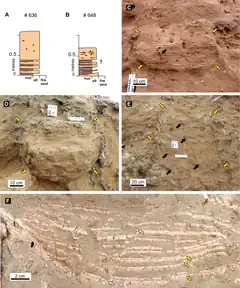 Fossil burrow fills in the Cerro Azul Formation | |
| Type | Geological formation |
| Underlies | alluvium |
| Overlies | Arroyo Chasicó Formation or Crystalline basement |
| Thickness | 54 m (177 ft) (outcrop) 180 m (590 ft) (subsurface) |
| Lithology | |
| Primary | Siltstone, sandstone |
| Other | Conglomerate |
| Location | |
| Coordinates | 35.7°S 64.7°W |
| Approximate paleocoordinates | 35.9°S 62.7°W |
| Region | Buenos Aires & La Pampa Provinces |
| Country | Argentina |
| Extent | Colorado Basin |
| Type section | |
| Named for | Cerro Azul, Epecuén Lake |
| Named by | Linares et al. |
| Year defined | 1980 |
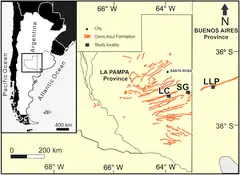 Outcrop map of the Cerro Azul Formation | |
The fluvial and aeolian siltstones, sandstones and tuffs of the formation contain many mammals, such as Thylacosmilus and Macrauchenia, reptiles, amphibians and fossils of terror birds as well as Argentavis, the largest flying bird ever discovered.
Description

The Cerro Azul Formation crops out in patches in the southwestern Buenos Aires Province and southeastern Pampa Province. The Epecuén Formation has been correlated to the Cerro Azul Formation in the early 2000s. The Cerro Azul and Epecuén Formations were named after the Cerro Azul ("Blue Hill") and Epecuén Lake where the formation crops out.[3] The formation overlies crystalline basement or the Arroyo Chasicó Formation.[4] The mammal assemblage of the Cerro Azul-Epecuén unit is the most diverse for the Huayquerian Late Miocene age, possibly ranging into the Pliocene.[5] The formation is considered contemporaneous with the Río Negro Formation of the Colorado Basin.[6][7]
The unit is characterized by a monotonous succession of loess containing moderately developed paleosols. In particular, the formation is considered as representing the interval between 10 and 5.7 Ma. The maximum exposed thickness in outcrop is 54 metres (177 ft), although the unit reaches about 180 metres (590 ft) in the subsurface.[8]
The Cerro Azul Formation deposits were described by Linares et al. in 1980.[3] They are discontinuous along the whole occupied area in the provinces of La Pampa and Buenos Aires. They are composed of silts, sandy silts and very thin silty sands, reddish and brown colored, with a homogeneous and compact general aspect, and frequent carbonate nodules and evidences of pedogenic processes. Visconti et al. (2010) interpreted them as eolian deposits characterized by loessic materials, with a high percentage of lithic fragments and volcaniclastic sediments.[9]
The sediments and their fauna belong to a sedimentary and faunal cycle, which followed the withdrawal (around 10 Ma) of a widespread marine transgression that extended from central Argentina, to western Uruguay and southern Paraguay and Brazil, the "Paraná Sea" or mar paranense in Spanish.[10]
Large cylindrical sediment-filled structures, 115 of which interpreted as mammal burrows occur within the loess-paleosol sequence of the formation.[11]
Fossil content
The following fossils have been recovered from the formation:[1]
Locations:
- La Pampa
- Barrancas Coloradas - Cerro Azul Formation - La Pampa
- Caleufú - Cerro Azul Formation - La Pampa
- Cerro El Chancho - Cerro Azul Formation - La Pampa
- Cerro Patagua - Cerro Azul Formation - La Pampa
- Estancia Don Mariano - Cerro Azul Formation - La Pampa
- Estancia El Recado - Cerro Azul Formation - La Pampa
- Estancia Ré - Cerro Azul Formation - La Pampa
- El Guanaco - Cerro Azul Formation - La Pampa
- Huayquerías de San Carlos - Cerro Azul Formation - La Pampa
- Laguna Chillhué - Cerro Azul Formation - La Pampa
- Laguna Guatraché - Cerro Azul Formation - La Pampa
- Quehué - Cerro Azul Formation - La Pampa
- Salinas Grandes de Hidalgo - Cerro Azul Formation - La Pampa
- Telen - Cerro Azul Formation - La Pampa
- Buenos Aires
- Bajo Giuliani - Cerro Azul Formation - Buenos Aires
- Barrancas de Sarmiento - Cerro Azul Formation - Buenos Aires
- Eduardo Castex - Cerro Azul Formation - Buenos Aires
- Estancia los Médanos - Cerro Azul Formation - Buenos Aires
- Estancia Quiñi-Malal - Cerro Azul Formation - Buenos Aires
- Grünbein Cantera Seminario - Cerro Azul Formation - Buenos Aires
- Grünbein Cantera Seminario Level 2 - Cerro Azul Formation - Buenos Aires
- Laguna Epecuén - Cerro Azul Formation - Buenos Aires
- Laguna La Paraguaya - Cerro Azul Formation - Buenos Aires
- Puesto Colorado - Cerro Azul Formation - Buenos Aires
- Ruta 14 - Cerro Azul Formation - Buenos Aires
- Arroyo Guaminí - Epecuén Formation - Buenos Aires
- Carhué - Epecuén Formation - Buenos Aires
- Laguna de los Paraguayos - Epecuén Formation - Buenos Aires
- Robilote Field - SE of Epecuén lagoon & E of Laguna de Epecuén - Epecuén Formation - Buenos Aires
- Salinas Grandes de Hidalgo - Epecuén Formation - Buenos Aires
| Group | Clade | Taxa | Location | Images | Notes |
|---|---|---|---|---|---|
| Mammals | Carnivora | Cyonasua brevirostris | Salinas de Hidalgo | [12] | |
| C. prebrevirostris | Salinas de Hidalgo | [12] | |||
| Cyonasua sp. | Telén | [13] | |||
| Sparassodonta | Borhyaenidium musteloides | Salinas de Hidalgo | [12] | ||
| Thylacosmilus atrox | El Guanaco Quehué Salinas de Hidalgo |  | [12][14] | ||
| Borhyaenidae indet. | Telén | [13] | |||
| Rodents | Abrocoma antiqua | Estancia Ré | [15] | ||
| Cardiatherium aff. orientalis | Laguna Chillhué Laguna Guatraché | [16] | |||
| Chasichimys bonaerense | Cerro Patagua | [17] | |||
| C. scagliai | Laguna Chillhué | [17] | |||
| Neocavia pampeana | Estancia El Recado | [18] | |||
| Lagostomus pretrichodactyla | Salinas de Hidalgo | [12] | |||
| Neophanomys pristinus | Estancia Don Mariano Quehué | [19] | |||
| Palaeoctodon aff. simplicidens | Bajo Giuliani | [20][21] | |||
| Pampamys emmonsae | Laguna Chillhué Bajo Giuliani Estancia Ré | [21][22] | |||
| Phtoramys hidalguense | Barrancas Coloradas Salinas de Hidalgo | [21][23] | |||
| Proctenomys simpsoni | El Guanaco Barrancas Coloradas | [24] | |||
| Reigechimys octodontiformis | Bajo Giuliani Estancia Ré | [25] | |||
| R. plesiodon | Laguna Chillhué | [26] | |||
| R. simplex | Bajo Giuliani | [25] | |||
| Tetrastylus araucanus | Salinas de Hidalgo | [12] | |||
| Theridomysops parvulus | Telén | [13] | |||
| Xenodontomys ellipticus | Grünbein Cantera Seminario Barrancas de Sarmiento | [27] | |||
| Phtoramys cf. hidalguense | Grünbein Cantera Seminario | [27] | |||
| Cardiomys sp. | Salinas de Hidalgo | [12] | |||
| Chasichimys sp. | Bajo Giuliani | [17] | |||
| Dolicavia sp. | Grünbein Cantera Seminario | [27] | |||
| Lagostomus (Lagostomopsis) sp. | Grünbein Cantera Seminario Barrancas de Sarmiento Estancia Ré Salinas de Hidalgo | [12][15][27] | |||
| Neocavia sp. | Grünbein Cantera Seminario | [27] | |||
| Neophanomys sp. | Estancia Ré | [28] | |||
| Orthomyctera sp. | Grünbein Cantera Seminario Salinas de Hidalgo | [27][12] | |||
| Palaeocavia sp. | Grünbein Cantera Seminario Barrancas de Sarmiento Estancia Ré | [12][15][27] | |||
| Phtoramys sp. | Estancia Ré | [15] | |||
| Protabrocoma sp. | Telén | [13] | |||
| Tetrastylus sp. | Telén | [13] | |||
| aff. Clyomys sp. | Barrancas Coloradas | [21] | |||
| Caviidae indet. | Barrancas de Sarmiento | [27] | |||
| Ctenomyidae indet. | Telén | [13] | |||
| Echimyidae indet. | Telén | [13] | |||
| Hydrochoeridae indet. | Salinas de Hidalgo | [14] | |||
| Octodontoidea indet. | Estancia Ré | [28] | |||
| Xenarthra | Aspidocalyptus castroi | Robilote Field Salinas de Hidalgo | [12][29] | ||
| Coscinocercus brachyurus | Robilote Field Salinas de Hidalgo | [12][29] | |||
| C. marcalaini | Robilote Field Salinas de Hidalgo | [12][29] | |||
| Hoplophractus tapinocefalus | Laguna de los Paraguayos Salinas de Hidalgo | [12][30] | |||
| Plohophorus araucanus | Salinas de Hidalgo | [12] | |||
| Proscelidodon gracillimus | Estancia Don Mariano Huayquerías de San Carlos Laguna Epecuén Bajo Giuliani Laguna Chillhué Loventué Salinas Grandes de Hidalgo Quehué Barrancas Coloradas Estancia Ré Arroyo Guaminí Laguna de los Paraguayos Carhué | [31][32] [33][34] | |||
| Aspidocalyptus sp. | Telén | [13] | |||
| Coscinocercus sp. | Telén | [13] | |||
| Eosclerocalyptus sp. | Laguna La Paraguaya |  | [35] | ||
| Eumysops sp. | Laguna Chillhué | [21] | |||
| Hoplophorus sp. | Telén | [13] | |||
| Hoplophractus sp. | Telén | [13] | |||
| Plesiomegatherium sp. | Salinas de Hidalgo | [12] | |||
| cf. Aspidocalyptus sp. | Grünbein Cantera Relleno Sanitario Level 2 | [27] | |||
| cf. Pseudoplohophorus sp. | Grünbein Cantera Relleno Sanitario Level 2 | [27] | |||
| Glyptodontidae indet. | Laguna La Paraguaya Salinas Grandes de Hidalgo | [35] | |||
| Mylodontidae indet. | Telén | [13] | |||
| Cingulata | Chasicotatus ameghinoi | Laguna Chillhué Estancia Don Mariano Cerro Patagua Cerro El Chancho Cerro de los Guanacos Puesto Colorado Estancia Quiñi-Malal Bajo Giuliani El Guanaco Telen El Recado Laguna Guatraché Loventué Quehué Barrancas Coloradas Estancia Ré Salinas de Hidalgo | [13][36] [37][38] | ||
| Chasicotatus cf. peiranoi | Grünbein Cantera Relleno Sanitario Level 2 | [27] | |||
| Chorobates villosissimus | Laguna Chillhué Estancia Don Mariano Grünbein Cantera Relleno Sanitario Level 2 Puesto Colorado Ruta 14 Estancia Quiñi-Malal El Guanaco Telen El Recado Loventué Quehué Estancia Ré Salinas de Hidalgo | [12][27][36] [37][38] | |||
| Doellotatus chapadmalensis | El Recado Salinas de Hidalgo | [12][38] | |||
| D. inornatus | Laguna Chillhué Estancia Don Mariano Grünbein Cantera Seminario Puesto Colorado Ruta 14 El Guanaco El Recado Laguna Guatraché Loventué Quehué Barrancas Coloradas Estancia Ré Telén Salinas de Hidalgo | [12][27] [36][37] [38][13] | |||
| D. cf. praecursor | Grünbein Cantera Seminario | [27] | |||
| Macrochorobates chapalmalensis | El Guanaco Barrancas Coloradas | [36] | |||
| M. scalabrinii | Laguna Chillhué Estancia Don Mariano Telen Loventué Quehué Salinas de Hidalgo | [12][36] [37][13] | |||
| Macroeuphractus morenoi | Grünbein Cantera Relleno Sanitario Level 2 Puesto Colorado Laguna Chillhué Telen El Recado Laguna Guatraché Loventué Quehué Barrancas Coloradas Estancia Ré Salinas de Hidalgo | [12][27] [36][37] [38][13] | |||
| M. retusus | Salinas de Hidalgo | [12] | |||
| Proeuphractus limpidus | Laguna Chillhué Telén | [36][13] | |||
| Vetelia perforata | Cerro Patagua Cerro de los Guanacos Telén | [36][37][13] | |||
| Zaedyus pichiy | Laguna Chillhué Telen Quehué |  | [37] | ||
| Chasicotatus sp. | El Recado | [27][38] | |||
| Chorobates sp. | Grünbein Cantera Seminario | [27] | |||
| Doellotatus sp. | Laguna La Paraguaya | [38] | |||
| Macrochorobates sp. | Grünbein Cantera Relleno Sanitario Level 2 El Recado | [27][38] | |||
| Paleuphractus sp. | Salinas de Hidalgo | [12] | |||
| Proeuphractus sp. | Laguna Chillhué Cerro Patagua Telen El Recado Laguna Guatraché Quehué Salinas de Hidalgo | [12][36] [37][38] [13] | |||
| Didelphimorphia | Hyperdidelphys pattersoni | El Guanaco Telén | [14][13] | ||
| Thylamys pinei | Laguna Chillhué | [21] | |||
| T. zetti | Estancia Ré Arroyo Guaminí | [15][33] | |||
| Thylatheridium dolgopolae | El Guanaco Quehué Telén | [39][13] | |||
| T. hudsoni | Bajo Giuliani Telén | [14][13] | |||
| Zygolestes tatei | Bajo Giuliani | [14][21] | |||
| Hyperdidelphys sp. | Salinas Grandes de Hidalgo | [40] | |||
| Thylatheridium sp. | Estancia Ré Telén | [15][13] | |||
| Didelphinae indet. | Telén | [13] | |||
| Lutreolina sp. | Salinas de Hidalgo | [12] | |||
| Sparassocynidae indet. | Telen | [14][13] | |||
| Ungulates | Diplasiotherium pampa | Bajo Giuliani Laguna Chillhué Salinas de Hidalgo | [12][41] | ||
| Eoauchenia cingulata | Robilote Field Salinas de Hidalgo | [12][29] | |||
| E. primitiva | El Guanaco | [41] | |||
| Epecuenia thoatherioides | Robilote Field Salinas de Hidalgo | [12][29] | |||
| Huayqueriana cristata | Robilote Field | [29] | |||
| Macrauchenia latidens | Salinas de Hidalgo | .jpg.webp) | [12] | ||
| cf. Brachytherium cuspidatum | Telén Salinas de Hidalgo | [12][13] | |||
| Neobrachytherium sp. | Bajo Giuliani Salinas de Hidalgo | [12][41] | |||
| Promacrauchenia sp. | Grünbein Cantera Relleno Sanitario Level 2 Salinas de Hidalgo | [12][27] | |||
| Proterotheriidae indet. | Bajo Giuliani Telén | [41][13] | |||
| Litopterna indet. | Telén | [13] | |||
| Notoungulata | Hemihegetotherium achataleptum | Cerro Patagua Eduardo Castex Cerro de los Guanacos Puesto Colorado Bajo Giuliani Laguna Chillhué Loventué Salinas de Hidalgo | [42][37] [36][43] | ||
| H. lazai | Salinas de Hidalgo | [12] | |||
| Paedotherium bonaerense | Barrancas de Sarmiento | [27] | |||
| Paedotherium minor | Laguna La Paraguaya Estancia Ré Salinas de Hidalgo | [12][35] | |||
| Paedotherium cf. minor | Grünbein Cantera Seminario | [27] | |||
| Pisanodon nazari | Salinas de Hidalgo | [12] | |||
| Pseudotypotherium carhuense | Robilote Field Salinas de Hidalgo | [12][29] | |||
| Tremacyllus impressus | Grünbein Cantera Seminario Bajo Giuliani Laguna Chillhué Salinas Grandes de Hidalgo Quehué Barrancas Coloradas | [27][43] | |||
| Typotheriodon grandis | Robilote Field | [29] | |||
| Typotheriopsis minimus | Robilote Field | [29] | |||
| Paedotherium sp. | Bajo Giuliani Laguna Chillhué Estancia Ré | [44] | |||
| Mesotheriinae indet. | Laguna La Paraguaya Telén | [13][35] | |||
| Polydolopimorphia | Argyrolagus rusconii | Bajo Giuliani El Guanaco Barrancas Coloradas | [14] | ||
| Argyrolagidae indet. | Telén | [13] | |||
| Paucituberculata | Pliolestes venetus | Bajo Giuliani Laguna Chillhué | [14] | ||
| Birds | Phorusrhacidae | Devincenzia pozzi | Carhué | [45] | |
| Procariama simplex | Salinas de Hidalgo | 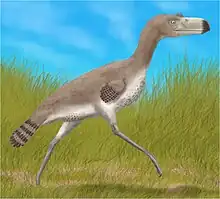 | [46] | ||
| Phorusrhacidae indet. | Laguna Guatraché Carhué | [45] | |||
| Cathartidae | Argentavis magnificens | Carhué | 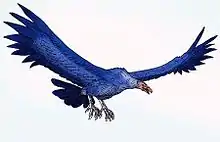 | [12] | |
| Tinamiformes | Eudromia sp. | Salinas de Hidalgo | [45] | ||
| Nothura sp. | Bajo Giuliani El Guanaco Salinas de Hidalgo | [45] | |||
| Rheidae | Rhea sp. | Salinas de Hidalgo | [45] | ||
| Reptiles | Squamata | Tupinambis sp. | Telén | [13] | |
| Testudines | Chelidae indet. | Telén | [13] | ||
| Testudinidae indet. | Salinas de Hidalgo | [47] | |||
| Amphibians | Ceratophrynidae | Lepidobatrachus sp. | Quehué | [48] | |
SALMA correlations
| Formation | Cerro Azul | Ituzaingó | Paraná | Camacho | Raigón | Andalhuala | Chiquimil | Las Flores | Maimará | Palo | Pebas | Muyu | Rosa | Saldungaray | Salicas | Urumaco | Map |
|---|---|---|---|---|---|---|---|---|---|---|---|---|---|---|---|---|---|
| Basin | Colorado | Paraná | Hualfín | Tontal | Andes | Salta | Amazon | Huasi | Altiplano | BA | Velasco | Falcón | 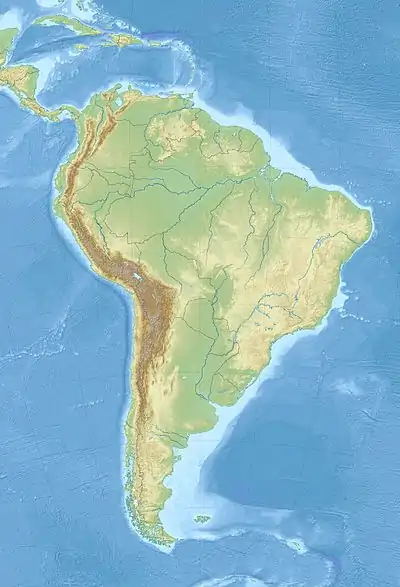 Cerro Azul Formation (South America) | ||||
| Country | |||||||||||||||||
| Cardiatherium | |||||||||||||||||
| Lagostomus | |||||||||||||||||
| Macroeuphractus | |||||||||||||||||
| Proeuphractus | |||||||||||||||||
| Pronothrotherium | |||||||||||||||||
| Pseudotypotherium | |||||||||||||||||
| Thylacosmilus | |||||||||||||||||
| Xotodon | |||||||||||||||||
| Macraucheniidae | |||||||||||||||||
| Primates | |||||||||||||||||
| Rodents | |||||||||||||||||
| Reptiles | |||||||||||||||||
| Birds | |||||||||||||||||
| Terror birds | |||||||||||||||||
| Flora | |||||||||||||||||
| Environments | Aeolian-fluvial | Fluvio-deltaic | Fluvial | Fluvio-lacustrine | Fluvial | Fluvio-lacustrine | Fluvio-deltaic | ||||||||||
| Volcanic | Yes | ||||||||||||||||
References
- Cerro Azul Formation in the Paleobiology Database
- Epecuén Formation in the Paleobiology Database
- Visconti et al., 2010, p.259
- Visconti et al., 2010, p.262
- Carrillo et al., 2015, p.5
- Pérez, 2012, p.11
- Visconti et al., 2010, p.258
- Cardonatto & Melchor, 2018, p.2
- Caleufú at Fossilworks.org
- Verzi & Montalvo, 2008, p.285
- Cardonatto & Melchor, 2018, p.1
- Vizcaino & Fariña, 1999
- Montalvo et al., 2008
- Goin et al., 2000
- Montalvo et al., 2016
- Vucetich et al., 2014
- Verzi, 1999
- Montalvo & Rocha, 2003
- Verzi et al., 2011
- Montalvo & Casadio, 1988
- Verzi et al., 2008
- Verzi et al., 1995
- Pascual et al., 1965
- Verzi et al., 1991
- Sostillo et al., 2014
- Verzi et al., 1994
- Deschamps, 2005
- Cerdeño et al., 2017
- Cabrera, 1939
- Zurita & Aramayo, 2007
- Montalvo et al., 2020
- Rovereto, 1914
- Goin, 1997
- Ortega, 1967
- Cardonatto & Melchor, 2018, p.16
- Urrutia et al., 2008
- Esteban et al., 2000
- Esteban et al., 2003
- Goin & Montalvo, 1988
- Goin & Pardiñas, 1996
- Schmidt et al., 2018
- Cerdeño & Montalvo, 2002
- Sostillo et al., 2018
- Cerdeño et al., 2017
- Cenizo et al., 2012
- Vezzosi, 2012
- De la Fuente et al., 2018
- Nicoli, 2017
Bibliography
- Geology
- Pérez, Mariano. 2012. Análisis paleoambiental del miembro superior de la Formación Río Negro (Mioceno-Plioceno de Patagonia septentrional): un ejemplo de interacción fluvio-eólica compleja (BSc. thesis), 1–47. Universidad Nacional de La Pampa. Accessed 2018-09-10.
- Visconti, Graciela; Ricardo N. Melchor; Claudia I. Montalvo; Aldo M. Umazano, and Elena E. De Elorriaga. 2010. Anáisis litoestratigráfico de la Formación Cerro Azul (Mioceno Superior) de la Provincia de La Pampa. Revista de la Asociación Geológica Argentina 67. 257–265. .
- Paleontology
- Montalvo, C. I.; A. R. Miño Boilini; R. Sostillo; E. Cerdeño; M. C. Cardonatto, and R. A. Bonini. 2020. The Scelidotheriinae Proscelidodon gracillimus (Xenarthra: Mylodontidae) from the Cerro Azul Formation (late Miocene), Argentina: Ontogenetic variability and taxonomy. Journal of South American Earth Sciences 102754. .. .
- Rasia, L. L.; R. A. Bonini, and A. M. Candela. 2020. Nuevos registros de Lagostomus Brookes, 1828 (Rodentia, Chinchillidae) en el Mioceno tardío de Argentina y su importancia bioestratigráfica. Andean Geology 47. . Accessed 2020-08-13.
- Cardonatto, M. C., and R. N. Melchor. 2018. Large mammal burrows in late Miocene calcic paleosols from central Argentina: paleoenvironment, taphonomy and producers. PeerJ 6. e4787. Accessed 2020-08-13.
- De la Fuente, M. S.; G. G. Zacarias, and E. Vlachos. 2018. A review of the fossil record of the South American turtles of the clade Pan-Testudinoidea. Bulletin of the Peabody Museum of Natural History 59. 269–286. Accessed 2020-08-13.
- Madozzo Jaén, M. Carolina; M. Encarnación Pérez; Claudia I. Montalvo, and Rodrigo L. Tomassini. 2018. Systematic review of Neocavia from the Neogene of Argentina: Phylogenetic and evolutionary implications. Acta Palaeontologica Polonica 63(2). 241–260. Accessed 2019-02-11.
- Schmidt, G. I.; C. I. Montalvo; R. Sostillo, and E. Cerdeño. 2018. Proterotheriidae (Mammalia, Litopterna) from the Cerro Azul Formation (late Miocene), La Pampa Province, Argentina. Journal of South American Earth Sciences 83. 165–177. .
- Sostillo, R.; E. Cerdeño, and C. Montalvo. 2018. Taxonomic implications of a large sample of Tremacyllus (Hegetotheriidae: Pachyrukhinae) from the late Miocene Cerro Azul Formation of La Pampa, Argentina. Ameghiniana 55. 407–422. .
- Cerdeño, E.; C. I. Montalvo, and R. Sostillo. 2017. Deciduous dentition and eruption pattern in late Miocene Pachyrukhinae (Hegetotheriidae, Notoungulata) from La Pampa Province, Argentina. Historical Biology 29. 359–375. .
- Nicoli, F. 2017. The presence of Lepidobatrachus (Anura, Ceratophryidae) in the Neogene of La Pampa Province, Argentina. Ameghiniana 54. 700–705. .
- Montalvo, C. I.; R. L. Tomassini, and R. Sostillo. 2016. Leftover prey remains: a new taphonomic mode from the Late Miocene Cerro Azul Formation of Central Argentina. Lethaia 49. 219–230. .
- Carrillo, Juan D.; Analía Forasiepi; Carlos Jaramillo, and Marcelo R. Sánchez Villagra. 2015. Neotropical mammal diversity and the Great American Biotic Interchange: spatial and temporal variation in South America's fossil record. Frontiers in Genetics 5. 1–11. .
- Sostillo, Renata; Claudia I. Montalvo, and Diego H. Verzi. 2014. A new species of Reigechimys (Rodentia, Echimyidae) from the Late Miocene of central Argentina and the evolutionary pattern of the lineage. Ameghiniana 51(4). 284–294. Accessed 2019-02-12.
- Vucetich, M. G.; C. M. Deschamps; E. C. Vieytes, and C. I. Montalvo. 2014. Late Miocene Capybaras from Argentina: Skull Anatomy, Taxonomy, Evolution, and Biochronology. Acta Palaeontologica Polonica 59. 517–535. .
- Cenizo, M. M.; C. P. Tambussi, and C. I. Montalvo. 2012. Late Miocene continental birds from the Cerro Azul Formation in the Pampean region (central-southern Argentina). Alcheringa: An Australasian Journal of Palaeontology 36. 47–68. .
- Vezzosi, Raúl Ignacio. 2012. First record of Procariama simplex Rovereto, 1914 (Phorusrhacidae, Psilopterinae) in the Cerro Azul Formation (upper Miocene) of La Pampa Province; remarks on its anatomy, palaeogeography and chronological range. Alcheringa: An Australasian Journal of Palaeontology 36. 157–169. .
- Verzi, D. H.; E. C. Vieytes, and C. I. Montalvo. 2011. Dental evolution in Neophanomys (Rodentia, Octodontidae) from the late Miocene of central Argentina. Geobios 44. 621–633. .
- Montalvo, C. I.; R. N. Melchor; G. Visconti, and E. Cerdeño. 2008. Vertebrate taphonomy in loess-palaeosol deposits: A case study from the late Miocene of Central Argentina. Geobios 41. 133–143. .
- Verzi, D. H., and C. I. Montalvo. 2008. The oldest South American Cricetidae (Rodentia) and Mustelidae (Carnivora): Late Miocene faunal turnover in Central Argentina and the Great American Biotic Interchange. Palaeogeography, Palaeoclimatology, Palaeoecology 267. 284–291. .
- Verzi, D. H.; C. I. Montalvo, and C. M. Deschamps. 2008. Biostratigraphy and biochronology of the Late Miocene of central Argentina: Evidence from rodents and taphonomy. Geobios 41. 145–155. .
- Urrutia, J. J.; C. I. Montalvo, and G. J. Scillato Yané. 2008. Dasypodidae (Xenarthra, Cingulata) de la Formación Cerro Azul (Mioceno tardío) de la provincia de La Pampa, Argentina. Ameghiniana 45. 289–302. .
- Verzi, Diego H.; Claudia I. Montalvo, and Cecilia M. Deschamps. 2008. Biostratigraphy and biochronology of the Late Miocene of central Argentina: Evidence from rodents and taphonomy. Geobios 41. 145–155. Accessed 2017-08-15.
- Zurita, A. E., and S. A. Aramayo. 2007. New remains of Eosclerocalyptus tapinocephalus (Cabrera) (Mammalia, Xenarthra, Glyptodontidae): description and implications for its taxonomic status. Rivista Italiana di Paleontologia e Stratigrafia 113. 57–66. .
- Deschamps, C.M. 2005. Late Cenozoic mammal bio-chronostratigraphy in southwestern Buenos Aires Province, Argentina. Ameghiniana 42. 733–750. .
- Montalvo, C. I., and A. M. Rocha. 2003. Presencia de Neocavia Kraglievich (Rodentia, Caviidae) en la Formación Cerro Azul (Mioceno tardío - Plioceno temprano?) de La Pampa, Argentina. Ameghiniana 40. 501–504. .
- Esteban, G. I.; N. L. Nasif, and C. I. Montalvo. 2000. Nuevos registros de Dasypodidae (Xenarthra) del Mioceno tardío de la provincia de La Pampa, Argentina. Revista Espanola de Paleontología 16. 77–87. .
- Goin, F.J.; C. Montalvo, and G. Visconti. 2000. Los marsupiales (Mammalia) del Mioceno superior de la Formación Cerro Azul (Provincia de La Pampa, Argentina). Estudios Geológicos 56. 101–126. Accessed 2017-08-15.
- Verzi, D.H. 1999. The dental evidence on the differentiation of the ctenomyine rodents (Caviomorpha, Octodontidae, Ctenomyinae). Acta Theriologica 44. 263–282. .
- Vizcaíno, S. F., and R. A. Fariña. 1999. On the flight capabilities and distribution of the giant Miocene bird Argentavis magnificens (Teratornithidae). Lethaia 32. 271–278. .
- Goin, F. 1997. Thylamys zettii, nueva especie de marmosino (Marsupialia, Didelphidae) del Cenozoico tardio de la region pampeana. Ameghiniana 34. 481–484. .
- Goin, F. J., and U. F. J. Pardiñas. 1996. Revisión de las especies del Género Hyperdidelphys Ameghino, 1904 (Mammalia, Marsupialia, Didelphidae). Su significación filogenética, estratigráfica y adaptativa en el Neógeno del Cono Sur Sudamericano. Estudios Geológicos 52. 327–359. .
- Verzi, D. H.; M. G. Vucetich, and C. I. Montalvo. 1995. Un nuevo Eumysopinae (Rodentia, Echimyidae) de Mioceno tardío de la Provincia de La Pampa y consideraciones sobre la historia de la subfamilia. Ameghiniana 32. 191–195. .
- Goin, F.J., and C. Montalvo. 1988. Revisión sistemática y reconocimiento de una nueva especie del género Thylatheridium Reig (Marsupialia, Didelphidae). Ameghiniana 25. 161–167. .
- Montalvo, C. I., and S. Casadio. 1988. Presencia del género Paleoctodon (Rodentia, Octodontidae) en el Huayqueriense (Mioceno tardío) de la Provincia de La Pampa. Ameghiniana 25. 111–114. .
- Ortega, E. 1967. Descripcion de los restos de un Scelidotheriinae (Edentata, Mylodontidae) de edad Huayqueriense. Algunas consideraciones en torno a la filogenia de los Scelidotheriinae. Ameghiniana 5. 109–120. .
- Pascual, R.; J. Pisano, and E. J. Ortega. 1965. Un nuevo Octodontidae (Rodentia, Caviomorpha) de la formacion Epecuen (Plioceno medio) de Hidalgo (Provincia de la Pampa). Consideraciones sobre los Ctenomyinae Reig, 1958, y la morfologia de sus molariformes. Ameghiniana 4. 19–30. .
- Cabrera, A. 1939. Sobre Vertebrados Fósiles del Plioceno de Adolfo Alsina. Revista del Museo de La Plata 2. 3–35. .
- Rovereto, C. 1914. Los Estratos Araucanos y sus fósiles. Anales del Museo de Historia Natural de Buenos Aires 25. 1–24. .